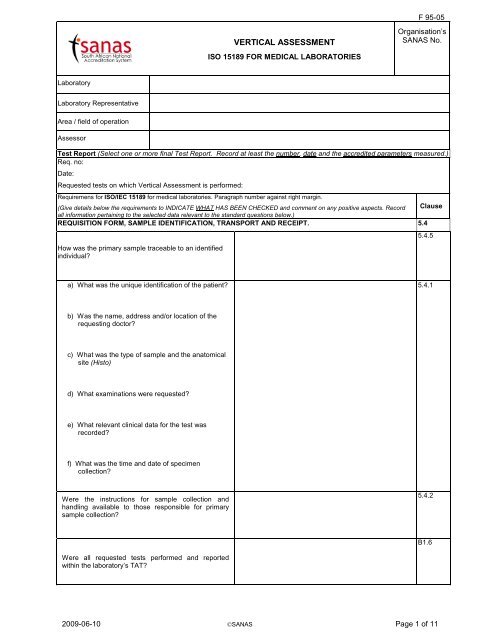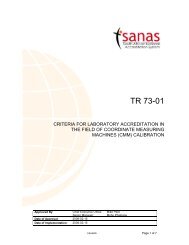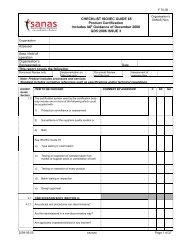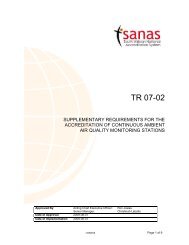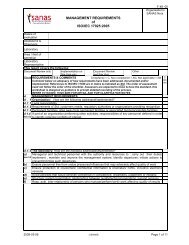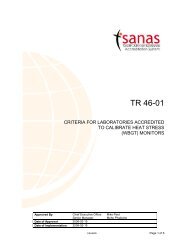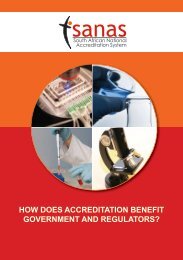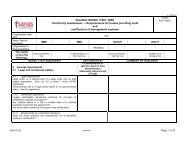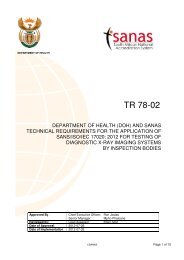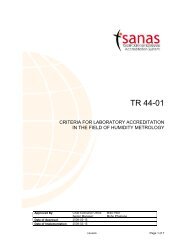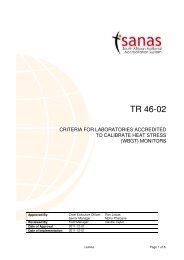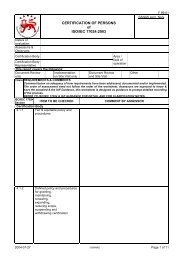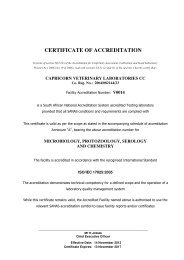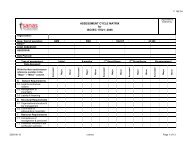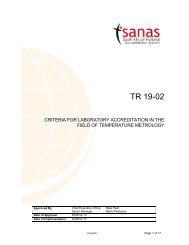VERTICAL ASSESSMENT - Sanas
VERTICAL ASSESSMENT - Sanas
VERTICAL ASSESSMENT - Sanas
Create successful ePaper yourself
Turn your PDF publications into a flip-book with our unique Google optimized e-Paper software.
F 95-05<br />
<strong>VERTICAL</strong> <strong>ASSESSMENT</strong><br />
ISO 15189 FOR MEDICAL LABORATORIES<br />
Organisation’s<br />
SANAS No.<br />
Laboratory<br />
Laboratory Representative<br />
Area / field of operation<br />
Assessor<br />
Test Report (Select one or more final Test Report. Record at least the number, date and the accredited parameters measured.)<br />
Req. no:<br />
Date:<br />
Requested tests on which Vertical Assessment is performed:<br />
Requiremens for ISO/IEC 15189 for medical laboratories. Paragraph number against right margin.<br />
(Give details below the requirements to INDICATE WHAT HAS BEEN CHECKED and comment on any positive aspects. Record Clause<br />
all information pertaining to the selected data relevant to the standard questions below.)<br />
REQUISITION FORM, SAMPLE IDENTIFICATION, TRANSPORT AND RECEIPT. 5.4<br />
How was the primary sample traceable to an identified<br />
individual?<br />
5.4.5<br />
a) What was the unique identification of the patient?<br />
5.4.1<br />
b) Was the name, address and/or location of the<br />
requesting doctor?<br />
c) What was the type of sample and the anatomical<br />
site (Histo)<br />
d) What examinations were requested?<br />
e) What relevant clinical data for the test was<br />
recorded?<br />
f) What was the time and date of specimen<br />
collection?<br />
Were the instructions for sample collection and<br />
handling available to those responsible for primary<br />
sample collection?<br />
5.4.2<br />
B1.6<br />
Were all requested tests performed and reported<br />
within the laboratory’s TAT?<br />
2009-06-10 ©SANAS Page 1 of 11
F 95-05<br />
Did the laboratory report form contain, but not limited<br />
to, the following:<br />
5.8.3<br />
a) Clear and concise results, including the units<br />
of measurement (where applicable);<br />
b) The identification of the laboratory that issued<br />
the report;<br />
c) The patient’s name, address and hospital<br />
number (where applicable);<br />
d) The name and address of the person<br />
requesting the test;<br />
e) The date and time of specimen collection and<br />
the time received by the laboratory;<br />
f) Date and time of release of the report;<br />
g) The type of sample & tests requested;<br />
h) Results reported in SI units where applicable;<br />
i) Reference ranges for each test (preferably by<br />
age and gender);<br />
j) Interpretation of results, where appropriate;<br />
k) Other comments (e.g. quality or adequacy of<br />
primary sample);<br />
l) Identification of person authorising the release<br />
of the report;<br />
m) Both original and corrected results, if relevant;<br />
n) The signature or authorisation of the person<br />
accepting responsibility for the content of the<br />
report;<br />
Where a sample was unsuitable for the performance<br />
of the test, did the report form clearly indicate this, is<br />
there a procedure in place to cater for this?<br />
5.8.5<br />
2009-06-10 ©SANAS Page 2 of 11
Are instructions for sample collection and handling<br />
available?<br />
F 95-05<br />
5.4.3<br />
a) Are there copies of or reference to :<br />
1) The list of available tests;<br />
2) Consent forms (where required);<br />
3) Instructions to patients on preparation<br />
before primary sample collection;<br />
4) Information for users of laboratory<br />
services on indications for and selection<br />
of test;<br />
b) Procedures for:<br />
1) Preparation of the patient;<br />
2) Identification of the primary sample;<br />
3) Collection, containers and preservatives;<br />
c) Instructions for:<br />
1) Completion of the request form (or<br />
procedure for electronic request);<br />
2) Type and amount of primary sample;<br />
3) Sample timing (if required);<br />
4) Special handling (refrigeration, urgent<br />
etc);<br />
5) Labelling of primary samples;<br />
6) Necessary clinical information;<br />
7) Positive identification;<br />
8) Identity of person collecting the sample;<br />
9) Safe disposal of collection material.<br />
2009-06-10 ©SANAS Page 3 of 11
F 95-05<br />
How did the laboratory ensure that samples that were<br />
transported to the laboratory:<br />
5.4.6<br />
a) Reached the laboratory within an appropriate<br />
time;<br />
b) Have not been exposed to temperatures<br />
outside an acceptable range, where<br />
appropriate;<br />
c) Have been transported safely in compliance<br />
with national, regional and local safety<br />
requirements;<br />
Are instructions for the receipt of samples in the<br />
reception area available, and were they followed?<br />
5.4.3<br />
What was the date and time of receipt of samples and<br />
the identity of the receiving officer?<br />
5.4.7<br />
Was this within the stipulated time frame?<br />
Are there are documented instructions in place for<br />
acceptance or rejection of primary samples?<br />
5.4.8<br />
Where compromised primary samples were accepted,<br />
was this stated on the final report and is there a<br />
procedure in place for this?<br />
When samples are split, how are the spilt portions<br />
traced back to the primary sample?<br />
5.4.12<br />
EXAMINATION PROCEDURES<br />
Are recognised methods used for these tests?<br />
5.5<br />
5.5.1<br />
If in-house procedure were used, was the validation<br />
carried out as per procedure and was the validation<br />
approved and the test approved for the intended use?<br />
Validations records shall include the following but is<br />
not limited to:<br />
5.5.2<br />
1. Validation procedure including acceptance<br />
criteria;<br />
2. Are the results that were obtained documented<br />
and available?<br />
2009-06-10 ©SANAS Page 4 of 11
3. Who reviewed the records of the validations<br />
and approved the procedure for the intended<br />
use?<br />
F 95-05<br />
5.5.2<br />
4. Did the performance specifications for each<br />
procedure relate to the intended use of that<br />
procedure?<br />
If there are any deviations on the instruction for use<br />
written by the manufacturer, was this reviewed,<br />
validated and documented?<br />
5.5.3<br />
Is there an inventory control system for supplies and<br />
did it include the recording of lot numbers of all<br />
relevant reagents, control materials and calibrators,<br />
the date of receipt and the date the material was<br />
placed in service?<br />
4.6.3<br />
Did the documented procedures/instructions available<br />
for all tests include , where applicable:<br />
a) The purpose of the examination;<br />
5.5.3<br />
5.8.11<br />
5.4.3 d)<br />
b) The principle of the procedure;<br />
c) Performance specifications including<br />
uncertainty of measurement;<br />
d) Primary sample;<br />
e) Type of container and additives;<br />
f) Required equipment and reagents;<br />
g) Calibration procedures;<br />
h) Step by step instructions;<br />
i) Quality Control procedures;<br />
j) Interferences (e.g. lipemia, hemolysis etc);<br />
k) Principle for calculating results, including<br />
measurement uncertainty;<br />
l) Biological reference interval;<br />
m) Patient reference ranges;<br />
n) Alert/critical values, where appropriate;<br />
o) Laboratory interpretation;<br />
p) Safety precautions (PPE, available and used);<br />
q) Potential sources of variability;<br />
r) Required calibrators and controls;<br />
s) The storage and preparation of materials;<br />
2009-06-10 ©SANAS Page 5 of 11
F 95-05<br />
t) The source of method e.g. literature<br />
references, manufacturers, leaflets etc.;<br />
u) Turnaround times for examination;<br />
5.5.3<br />
5.8.11<br />
5.4.3 d)<br />
(cont.)<br />
v) The storage conditions for specimens;<br />
w) Time limits for additional requests;<br />
x) Repeat examinations due to analytical failure.<br />
LABORATORY EQUIPMENT<br />
Note: All Instruments, reagents, consumables and analytical systems are included under this heading. 5.3<br />
What equipment was used to perform the tests?<br />
5.3.1<br />
If the equipment used was outside the permanent<br />
control of the laboratory, how did management<br />
ensure that the requirements of this standard were<br />
met?<br />
Is a programme and standard operating procedure<br />
available for monitoring in-service checks and<br />
calibrations performed on all equipment in the<br />
laboratory, and was this done?<br />
5.3.2<br />
How was the equipment uniquely labelled /<br />
otherwise identified?<br />
5.3.3<br />
Are records for each item of equipment<br />
maintained?<br />
5.3.4<br />
Do the records include the following:<br />
a) Identity of the equipment;<br />
b) Manufacturer’s name, type identification, and<br />
serial number or other unique identification;<br />
c) Manufacturer’s contact person and telephone<br />
number;<br />
d) Date received and date placed in service;<br />
e) Current location, where appropriate;<br />
f) Condition when received (e.g., new, used,<br />
reconditioned);<br />
g) Manufacturers instructions, if available, or<br />
reference to their retention;<br />
2009-06-10 ©SANAS Page 6 of 11
h) Performance records that confirm the<br />
equipments continued suitability for use (should<br />
include reports/certificates of all calibrations<br />
and or verifications including dates, time and<br />
results, adjustments, the criteria and due date<br />
of the next calibration together with the<br />
frequency of checks carried out between<br />
maintenance /calibration).<br />
F 95-05<br />
5.3.4<br />
(cont.)<br />
i) What maintenance was carried out to date and<br />
what maintenance is planned for the future;<br />
j) Are records of damage, malfunction,<br />
modification or repair to the equipment<br />
available?<br />
k) Predicted replacement date, if possible.<br />
Where are the operating manuals / standard<br />
operating procedures or similar documents for all<br />
relevant pieces of equipment stored and are they<br />
readily accessible in the laboratory?<br />
5.3.5<br />
What functional and safety checks on instruments<br />
are carried out and at what intervals?<br />
5.3.6<br />
Is there evidence that safety checks are<br />
documented to detect trends or malfunctions?<br />
Is defective equipment taken out of service and<br />
suitably labelled?<br />
5.3.7<br />
What measures were taken to reduce contamination<br />
of the equipment prior to servicing?<br />
5.3.8<br />
Where practicable, how is equipment labelled to<br />
indicate the calibration or verification status?<br />
5.3.9<br />
How was the equipment checked for proper function<br />
before being put to use after being out of the control<br />
of the laboratory?<br />
5.3.10<br />
2009-06-10 ©SANAS Page 7 of 11
F 95-05<br />
When computers or automated equipment are used<br />
for collection, processing, recording, reporting,<br />
storage or retrieval of data, how did management<br />
ensure that:<br />
5.3.11<br />
a) All software including that built into equipment<br />
was validated and documented as adequate<br />
for use;<br />
b) Were procedures in place for protecting the<br />
integrity of data at all times ;<br />
c) Are computers and automated equipment<br />
maintained and operated so as to ensure the<br />
integrity of data ;<br />
Does the laboratory have procedures for the safe<br />
handling, transport, storage and use of equipment to<br />
prevent its contamination or deterioration?<br />
Where calibrations gave rise to a set of correction<br />
factors, did the laboratory have procedures for<br />
ensuring that copies of prior correction factors were<br />
correctly updated?<br />
5.3.13<br />
ASSURING QUALITY OF EXAMINATION PROCEDURES 5.6<br />
Are all aspects of specimen handling and testing<br />
subjected to internal quality control procedures?<br />
5.6.1<br />
Where relevant and possible, has the uncertainty of<br />
results for each procedure been determined?<br />
(including sources which may influence results).<br />
5.6.2<br />
Is there a programme for calibration to verify<br />
trueness of a result to ensure it’s traceable to a<br />
reference? (eg: International References/ SI units)<br />
5.6.3<br />
Where calibration and verification is not possible,<br />
are other means for providing confidence in the<br />
results applied, which include but are not limited to<br />
the following:<br />
a) Participation in a suitable inter-laboratory<br />
comparison programme?<br />
b) Uses suitable reference material;<br />
2009-06-10 ©SANAS Page 8 of 11
c) Examines or calibrates by another procedure;<br />
F 95-05<br />
5.6.3<br />
(cont.)<br />
d) Performs ratio or reciprocity-type<br />
measurements;<br />
e) Uses mutual consent standards or methods<br />
which are clearly established;<br />
f) Documents statements on traceability<br />
supplied by the manufacturer or supplier.<br />
What external quality assessment scheme ( formal<br />
interlaboratory comparison programme ) does the<br />
lab participate in?<br />
5.6.4<br />
How does laboratory management monitor the<br />
results of external quality assessment and the<br />
participation in the implementation of corrective<br />
actions when control criteria is not fulfilled?<br />
Is there evidence that the External Quality<br />
Assessment programme provides clinically relevant<br />
challenges that mimic patient samples and have the<br />
effect of checking the entire examination process<br />
including the pre-and post examination procedures?<br />
If a formal interlaboratory comparison programme is<br />
not available what mechanism has the laboratory<br />
developed for determining the acceptability of<br />
procedures not otherwise evaluated?<br />
5.6.5<br />
Are inter-laboratory results clearly documented and<br />
monitored?<br />
Are appropriate actions taken if external and/or<br />
internal QC results are outside stated limits and are<br />
these corrective actions recorded?<br />
Is the type and frequency of external and internal<br />
QC samples for each procedure clearly stated?<br />
Where examinations are performed at different<br />
sites, have correlation studies been performed, and<br />
the data recorded?<br />
5.6.6<br />
2009-06-10 ©SANAS Page 9 of 11
F 95-05<br />
Where applicable, are Cause Analysis performed<br />
and the appropriate preventative action(s)<br />
implemented? Give examples.<br />
4.10.1<br />
Where adjustment factors had to be introduced as<br />
a result of the correlation studies, was this done<br />
timeously and the action recorded?<br />
5.6.7<br />
QUALITY & TECHNICAL RECORDS 4.13<br />
Are all records legible and stored in a manner such<br />
that they are readily retrievable?<br />
4.13.2<br />
(Note Records may be stored on any appropriate<br />
medium subject to national, regional or local legal<br />
requirements)<br />
Do storage facilities provide an environment which<br />
prevents damage, deterioration, loss or unauthorized<br />
access?<br />
Are any amendments made clearly marked, initialled<br />
and dated?<br />
4.3.2<br />
(g)<br />
Is it possible to establish an audit trail, by examining<br />
raw data, records, covering all activities from the<br />
receipt, identification and data input of samples, all<br />
stages of the analytical process, its storage in the<br />
laboratory and final disposal, and the issuing of the<br />
final reports?<br />
B1.5<br />
Is a file available which contains hard copies of all<br />
patient data? (results of tests and test process hard<br />
copy)<br />
B1.7<br />
PERSONNEL<br />
Were the examinations carried out by authorised and<br />
competent personnel?<br />
5.1.7<br />
5.1<br />
5.1.11<br />
Are training & competency records of staff who<br />
performed the tests available?<br />
Are there records of relevant educational and<br />
professional qualifications and current registration with<br />
the relevant body?<br />
2009-06-10 ©SANAS Page 10 of 11
F 95-05<br />
LABORATORY SAFETY, ACCOMODATION & ENVIRONMENTAL CONDITIONS 5.9<br />
Is there sufficient space to perform work without<br />
compromising the quality of work and safety of staff<br />
and patients?<br />
5.2.1<br />
Are all isles and corridors free from obstruction?<br />
5.2.4&5<br />
Is the laboratory environment monitored and of such<br />
a nature that it does not invalidate test results?<br />
5.2.6<br />
Are incompatible activities effectively separated from<br />
one another?<br />
5.2.7<br />
Is access to, and use of, all areas affecting the quality<br />
of test results are defined and controlled?<br />
5.2.10 &<br />
5.7.3<br />
Does the laboratory monitor, control and record<br />
environmental conditions ,as required by relevant<br />
specifications or where they may influence the quality<br />
of results? Attention should be paid to sterility, dust,<br />
electromagnetic inetrefernce, radiation, humidity,<br />
electrical supply, temperature and sound and<br />
vibrations levels.<br />
Are work areas clean?<br />
Is storage and disposal of dangerous materials done<br />
in a safe manner?<br />
GENERAL/ADDITIONAL COMMENTS AND MATTERS TO FOLLOW UP AT NEXT <strong>ASSESSMENT</strong><br />
Signed:<br />
Technical Assessor<br />
Signed:<br />
Lead Assessor<br />
2009-06-10 ©SANAS Page 11 of 11


